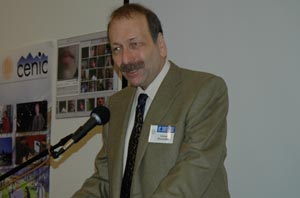With the completion of a new fiber-optic project, members of the campus community will be able to tap into an ultra-high-speed Internet network with much greater capacity than the campus's current connection.
The groundwork for the connection is expected to be in place by this time next year. The initial installation will provide a 10-fold increase in speed over the current connection, and will initially improve the campus's core network loop.
The tie-in to the California Research & Education Network 2 (CalREN 2) backbone also brings the potential for high-speed Internet connections for other schools, colleges, governments, and businesses in Santa Cruz County, Chancellor George Blumenthal said.
"It is a huge boost for the competitive advantage of UC Santa Cruz and the Monterey Bay Area, and has the potential to fuel the local economy and enable new opportunities for the City of Santa Cruz," Blumenthal said at a kick-off event January 24.
The dramatic increase in network connection speeds will be made possible by stringing nearly 30 miles of fiber-optic cable from Sunnyvale to Santa Cruz. High cost and treacherous terrain prevented UCSC from joining CalREN earlier.
"Having all the UC campuses connected to the network backbone is absolutely necessary," said Kris Hafner, associate vice president, information resources & communication, UC Office of the President.
UC Office of the President agreed to fund the $5.5 million project after Blumenthal persuaded them of its necessity, said Larry Merkley, UCSC vice provost, information technology. "It gives UCSC a new era of research capability and competitive edge," he said.
CalREN is operated by a nonprofit corporation known as CENIC, the Corporation for Education Network Initiatives in California. Its president, Jim Dolgonas, said the fiber-optic network links campuses throughout the state and will have important implications for researchers.
Professor Stan Woosley explained how astronomers in Santa Cruz will be able to work with the W. M. Keck Observatory in Hawaii without leaving their desks.
Margaret Morse, acting dean of the Arts, said students in the Digital Arts and New Media program will be able to use the increased bandwidth to collaborate on projects around the country and the world.
UC Santa Cruz is the last of the 10 UC campuses to be linked to the network. The cable work is expected to be completed by the end of the year.



